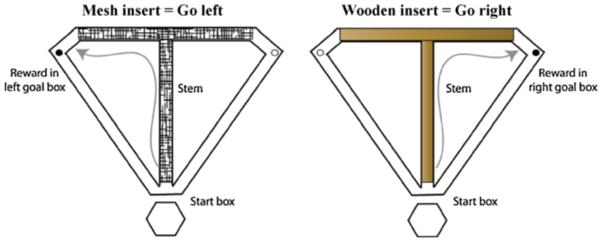Fig. 1.

Schematic of the conditional discrimination task. Wooden floor inserts were placed in the stem and goal arms of the T-maze prior to each trial. The inserts were covered on one side with black plastic mesh and the other side was left as plain wood. The texture and appearance of the insert acted as a conditional cue signaling which goal arm to visit in order to obtain a food reward. Trials were presented in a pseudorandom sequence. During the intertrial interval, the rats were confined to the start box using a large wooden barricade. Half of the rats in each experiment learned the “left on wood, right on mesh” rule: and the other half learned the “right on wood, left on mesh” rule. For the reversal phase of experiment 2, the rats that learned the “left on wood, right on mesh” rule were switched to the “right on wood, left on mesh rule” and vice versa.
